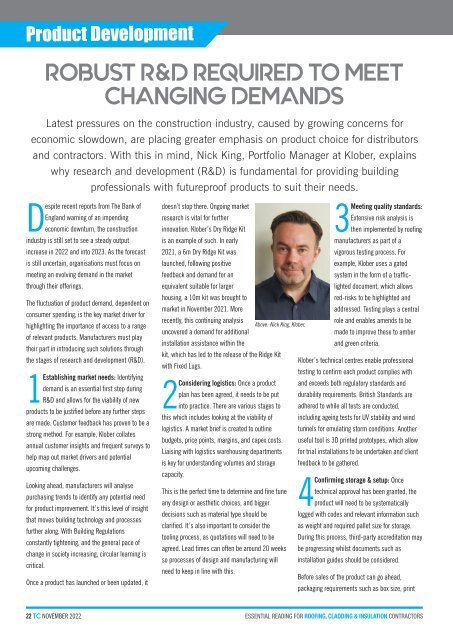November 2022
You also want an ePaper? Increase the reach of your titles
YUMPU automatically turns print PDFs into web optimized ePapers that Google loves.
Product Development<br />
ROBUST R&D REQUIRED TO MEET<br />
CHANGING DEMANDS<br />
Latest pressures on the construction industry, caused by growing concerns for<br />
economic slowdown, are placing greater emphasis on product choice for distributors<br />
and contractors. With this in mind, Nick King, Portfolio Manager at Klober, explains<br />
why research and development (R&D) is fundamental for providing building<br />
professionals with futureproof products to suit their needs.<br />
Despite recent reports from The Bank of<br />
England warning of an impending<br />
economic downturn, the construction<br />
industry is still set to see a steady output<br />
increase in <strong>2022</strong> and into 2023. As the forecast<br />
is still uncertain, organisations must focus on<br />
meeting an evolving demand in the market<br />
through their offerings.<br />
The fluctuation of product demand, dependent on<br />
consumer spending, is the key market driver for<br />
highlighting the importance of access to a range<br />
of relevant products. Manufacturers must play<br />
their part in introducing such solutions through<br />
the stages of research and development (R&D).<br />
1Establishing market needs: Identifying<br />
demand is an essential first step during<br />
R&D and allows for the viability of new<br />
products to be justified before any further steps<br />
are made. Customer feedback has proven to be a<br />
strong method. For example, Klober collates<br />
annual customer insights and frequent surveys to<br />
help map out market drivers and potential<br />
upcoming challenges.<br />
Looking ahead, manufacturers will analyse<br />
purchasing trends to identify any potential need<br />
for product improvement. It’s this level of insight<br />
that moves building technology and processes<br />
further along. With Building Regulations<br />
constantly tightening, and the general pace of<br />
change in society increasing, circular learning is<br />
critical.<br />
Once a product has launched or been updated, it<br />
doesn’t stop there. Ongoing market<br />
research is vital for further<br />
innovation. Klober’s Dry Ridge Kit<br />
is an example of such. In early<br />
2021, a 6m Dry Ridge Kit was<br />
launched, following positive<br />
feedback and demand for an<br />
equivalent suitable for larger<br />
housing, a 10m kit was brought to<br />
market in <strong>November</strong> 2021. More<br />
recently, this continuing analysis<br />
Above: Nick King, Klober.<br />
uncovered a demand for additional<br />
installation assistance within the<br />
kit, which has led to the release of the Ridge Kit<br />
with Fixed Lugs.<br />
2Considering logistics: Once a product<br />
plan has been agreed, it needs to be put<br />
into practice. There are various stages to<br />
this which includes looking at the viability of<br />
logistics. A market brief is created to outline<br />
budgets, price points, margins, and capex costs.<br />
Liaising with logistics warehousing departments<br />
is key for understanding volumes and storage<br />
capacity.<br />
This is the perfect time to determine and fine tune<br />
any design or aesthetic choices, and bigger<br />
decisions such as material type should be<br />
clarified. It’s also important to consider the<br />
tooling process, as quotations will need to be<br />
agreed. Lead times can often be around 20 weeks<br />
so processes of design and manufacturing will<br />
need to keep in line with this.<br />
3Meeting quality standards:<br />
Extensive risk analysis is<br />
then implemented by roofing<br />
manufacturers as part of a<br />
vigorous testing process. For<br />
example, Klober uses a gated<br />
system in the form of a trafficlighted<br />
document, which allows<br />
red-risks to be highlighted and<br />
addressed. Testing plays a central<br />
role and enables amends to be<br />
made to improve these to amber<br />
and green criteria.<br />
Klober’s technical centres enable professional<br />
testing to confirm each product complies with<br />
and exceeds both regulatory standards and<br />
durability requirements. British Standards are<br />
adhered to while all tests are conducted,<br />
including ageing tests for UV stability and wind<br />
tunnels for emulating storm conditions. Another<br />
useful tool is 3D printed prototypes, which allow<br />
for trial installations to be undertaken and client<br />
feedback to be gathered.<br />
4Confirming storage & setup: Once<br />
technical approval has been granted, the<br />
product will need to be systematically<br />
logged with codes and relevant information such<br />
as weight and required pallet size for storage.<br />
During this process, third-party accreditation may<br />
be progressing whilst documents such as<br />
installation guides should be considered.<br />
Before sales of the product can go ahead,<br />
packaging requirements such as box size, print<br />
22 TC NOVEMBER <strong>2022</strong>

















